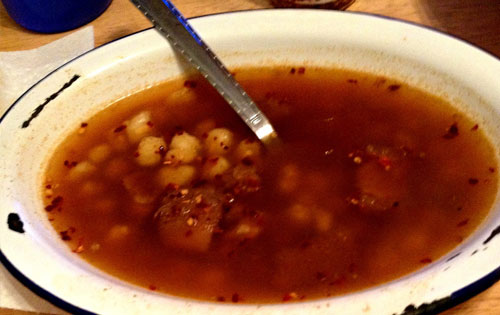
HISTORY OF MENUDO
Posted on December 5, 2013 by Alex R.
Menudo is a dish which came from Mexico, although it unclear exactly which part of the country it was created. Different regions claim to have invented it with the northern region, known for its chicken and beef production, claiming it came about from farmers who made the soup from spare parts of a slaughtered cow. Others say this dish was created in central Mexico. Although we do not know for sure where in the country this dish originated, we do know that different areas have different versions. The red Menudo, or “Menudo Rojo” is mainly found in Guadalajara and the northern regions of Mexico, and the white version is common in the Sinaloa area, the central part of Mexico.
Made from garlic, onion, chili, hominy, and tripe, Menudo is a very simple soup containing traditional Mexican ingredients. The Aztec’s who first inhabited Mexico had very simple diets consisting of corn based food, chilies, beans, squash, and different herbs. When the Spanish arrived in Mexico, they brought with them their diets of meat (poultry, pork, beef), rice, fruits, and vegetables, combining them together to create today’s “Mexican food”. Mexican dishes are known for being colorful and full of spices, and this soup embodies that, it has a nice spicy red broth, with white hominy (corn). It is no wonder this dish is so popular in the Mexican culture.
Unlike American’s who view soup as an appetizer, Mexican’s consider caldo (soup) a main dish and Menudo is a common meal. Known for being a hangover cure, it “raises the dead” according to Juan Miret’s article Flavors of the Season: Soup after the Holidays, and is eaten mainly during the Holiday Season.
Being a cure for such an ailment is one of the reasons my family eats it, and there is no better meal on New Year’s morning than a warm, spicy bowl of Menudo to get rid of the pains caused from partying the night before. My aunts would make a pot the day before so that in the morning all they would have to do was warm up a bowl and recover. One would think that a meal made from tripe, or cow stomach, would make someone with an already unsettled stomach feel so much worse, but it actually helps. Once you start eating, and the flavorful, “chiloso,” broth hits your tongue, you start to feel human again with just that one bite. All the ingredients work together to make a delicious and healing soup.

The History of Tamales
Posted on Jun 1st, 2017 by Tamara's Tamales
The tamale is recorded as early as 5000 BC, possibly 7000 BC in Pre-Columbian history. Initially, women were taken along in battle as army cooks to make the masa for the tortillas and the meats, stews, drinks, etc. As the warring tribes of the Aztec, Mayan, and Incan cultures grew, the demand of readying the nixtamal (corn) itself became so overwhelming a process, a need arose to have a more portable sustaining foodstuff. This requirement demanded the creativity of the women…..hence the tamale was born.
The tamales could be made ahead and packed, to be warmed as needed. They were steamed, grilled on the comal (grill) over the fire, or put directly on top of the coals to warm, or they were eaten cold. We have no record of which culture actually created the tamale but believe that one started and the others soon followed.
The tamale caught on very fast and eventually grew in variety and diversity unknown in today’s culture. There were plain tamales, tamales with red, green, yellow and black chile, tamales with chocolate, fish tamales, frog, tadpole, mushroom, rabbit, gopher, turkey, bee, egg, squash blossom, honey, ox, seed and nut tamales. There were white and red fruit tamales, white tamales, yellow tamales, dried meat tamales, roasted meat, stewed meat, bean and rice tamales. There were sweet sugar, pineapple, raisin, cinnamon, berry, banana and pumpkin tamales. There were hard and soft cheese tamales, roasted quail tamales, ant, potato, goat, wild boar, lamb and tomato tamales. Well, you get the idea.
The sizes, colors and shapes varied almost as much as the fillings. They were steamed, oven-roasted, fire-roasted, toasted, grilled, barbecued, fried and boiled. The wrappings were cornhusks, banana leaves, fabric, avocado leaves, soft tree bark, and other edible, non-toxic leaves. The most commonly used were corn husks, banana and avocado leaves.
Over the millennia, the varieties were minimized to the most common now being red and greed child, chicken, pork, beef, sweet, chile, cheese, and of late, vegetables. Also changed was the every day occurrence of making the tamales. With the preparation being so labor and time intensive, tamales became holiday fare, made for special occasions. This tradition remained for thousands of years, with the women of the family working together to make the sauces and meats, preparing the masa, and finally assembling and wrapping the tamales before steaming them in large pots on the stove. The process takes all day, the preparation often starting one of two days in advance. It is virtually unheard of to make a few tamales. In most cases, when they are made, hundreds are made at a time. Everyone, young, old, family and friends, is invited to tamale feasts where they are enjoyed, savored and loved by all.
Tamales have always been loved by the Hispanic people and in the 1900s they have become known and loved by all cultures as much as sushi and dim-sum, which were, in the past, also holiday and celebration foods.





